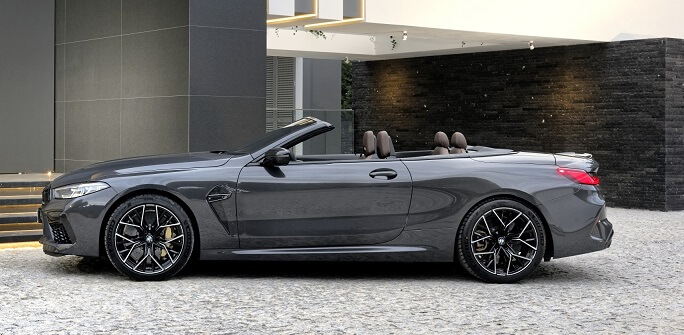Key specs
BMW M8 (Convertible) M8 Convertible (F91, facelift 2022) 2022,2023,2024,2025,2026
What is the body type, BMW M8 Convertible (F91, facelift 2022) Competition 4.4 V8 (625 Hp) xDrive Steptronic Sport 2022?
Cabriolet, 2 Doors, 4 Seats
How much power, BMW M8 Convertible (F91, facelift 2022) Competition 4.4 V8 (625 Hp) xDrive Steptronic Sport 2022?
625 Hp @ 6000 rpm.
142.2 Hp/l
How fast is the car, BMW M8 Convertible (F91, facelift 2022) Competition 4.4 V8 (625 Hp) xDrive Steptronic Sport 2022?
250 km/h, Electronically limited 155.34 mph
What is the engine size, BMW M8 Convertible (F91, facelift 2022) Competition 4.4 V8 (625 Hp) xDrive Steptronic Sport 2022?
4395 cm3
268.2 cu. in.
How many cylinders, BMW M8 Convertible (F91, facelift 2022) Competition 4.4 V8 (625 Hp) xDrive Steptronic Sport 2022?
8,
V-engine
What is the drivetrain, BMW M8 Convertible (F91, facelift 2022) Competition 4.4 V8 (625 Hp) xDrive Steptronic Sport 2022?
All wheel drive (4x4),
How long is this vehicle, BMW M8 Convertible (F91, facelift 2022) Competition 4.4 V8 (625 Hp) xDrive Steptronic Sport 2022?
4867 mm
191.61 in.
How wide is the vehicle, BMW M8 Convertible (F91, facelift 2022) Competition 4.4 V8 (625 Hp) xDrive Steptronic Sport 2022?
1907 mm
75.08 in.
What is the curb weight, BMW M8 Convertible (F91, facelift 2022) Competition 4.4 V8 (625 Hp) xDrive Steptronic Sport 2022?
2025 kg
4464.36 lbs.
BMW M8 (Convertible) M8 Convertible (F91, facelift 2022) 2022,2023,2024,2025,2026 Specs
General information
| Brand |
BMW |
| Model |
M8 (Convertible) |
| Version |
M8 Convertible (F91, facelift 2022) |
| Engine version |
Competition 4.4 V8 (625 Hp) xDrive Steptronic Sport |
| Year production start |
2022 |
| Vehicle type |
Cabriolet |
| Horsepower RPM |
625 Hp @ 6000 rpm. |
| Acceleration 0 - 100 kmh sec |
3.3 sec |
| Curb weight kg -lbs total |
2025 kg
4464.36 lbs.
|
| Overall length mm - inch |
4867 mm
191.61 in.
|
| Doors |
2 |
| Top Speed |
250 km/h, Electronically limited 155.34 mph |
Engine specs
| Designation model |
S63B44B |
| Engine position and orientation |
Front, Longitudinal |
| Cylinders |
8 |
| Position of cylinders |
V-engine |
| Displacement (liters) |
4395 cm3
268.2 cu. in.
|
| Eng. horsepower RPM |
625 Hp @ 6000 rpm.
|
| Horsepower per litre |
142.2 Hp/l
|
| Weight / horsepower kg/hp - hp/tons |
3.2 kg/Hp
308.6 Hp/tonne
|
| Weight / torque kg/Nm - Nm/tons |
2.7 kg/Nm, 370.4 Nm/tonne
2.7 kg/Nm
370.4 Nm/tonne
|
| Torque Nm RPM lb-ft RPM |
750 Nm @ 1800-5860 rpm.
553.17 lb.-ft. @ 1800-5860 rpm.
|
| Bore (mm in) |
89 mm
3.5 in.
|
| Stroke (mm in) |
88.3 mm
3.48 in.
|
| Compression ratio |
10 |
| Fuel type |
Petrol (Gasoline) |
| Valvetrain |
4 |
| Engine aspiration |
BiTurbo, Intercooler |
| Engine oil liters | quarts |
10 l
10.57 US qt | 8.8 UK qt
|
| Emission certification |
Euro 6d
|
| Powertrain architecture |
Internal Combustion engine |
| Engine location |
Front, Longitudinal
|
Transmission and Drive system
| Drive configuration |
All wheel drive (4x4)
|
Brakes
| Front brakes |
Ventilated discs |
| Rear brakes |
Ventilated discs |
| Anti-lock brake system |
ABS (Anti-lock braking system) |
Steering
| Steering type |
Steering rack and pinion |
| Turning diameter m - ft |
12.2 m
40.03 ft.
|
Suspension
| Front suspension |
Double wishbone |
| Rear suspension |
Independent multi-link suspension |
Wheels & Tyres
| Wheels size |
275/35 ZR20; 285/35 ZR20
|
| Wheels rims |
9.5J x 20; 10.5J x 20 |
Passenger
| Passengers seats |
4 |
| Trunk space min liter | cu. Ft. |
280-350 l
9.89 - 12.36 cu. ft.
|
Dimensions
| Overall length mm - inch |
4867 mm
191.61 in.
|
| Overall width mm -inch |
1907 mm
75.08 in.
|
| Overall height mm -inch |
1353 mm
53.27 in.
|
| Wheelbase mm - inch |
2827 mm
111.3 in.
|
| Track width front mm - inch |
1627 mm
64.06 in.
|
| Track width rear mm - inch |
1632 mm
64.25 in.
|
Weights
| Curb weight kg -lbs total |
2025 kg
4464.36 lbs.
|
| Gross weight kg -lbs total |
2440 kg
5379.28 lbs.
|
| Capacities kg - lbs |
415 kg
914.92 lbs.
|
| Fuel tank liters | gallons |
68 l
17.96 US gal | 14.96 UK gal
|
Fuel economy
| Combined fuel consumption (WLTP) |
11.2-11.6 l/100 km 21 - 20.28 US mpg |
Engine type
8 CYLINDER V-Engine
https://www.thecarspec.net/components/engine/8-cylinders-v

